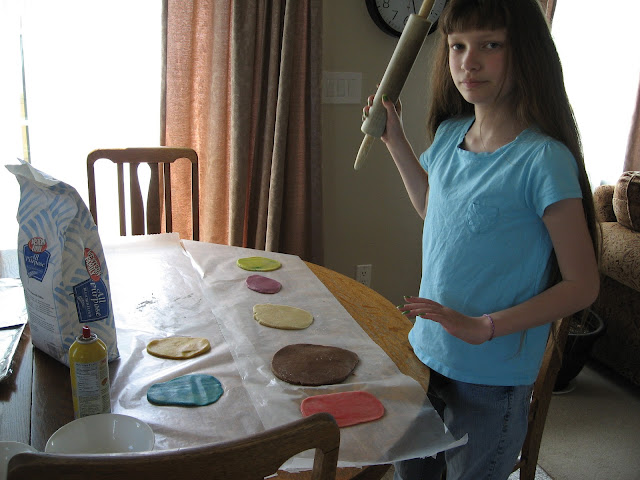After we made our paper frisbees the other day, I wasn't sure all the older children had a firm grasp of the formula we used for finding the interior angles of regular convex polygons. So today, I set the older girls (ages 11 and 13) to cutting polygons...
...into triangles...
...to use as templates for cutting sugar cookies from variously dyed dough...
...as part of a cookie review and clarification of the theorem...
...which, just to jog your memory is...
...(n - 2)180°/n, where n is the number of sides (or angles) of the polygon. For which, we made polygon cookies pieced together like the pictures below.
Each shape (after the triangle) can be divided into triangles, so the angles of the triangles altogether encompass the angles of the polygons.
If you count the triangles in each shape, you see there are two triangles less than the number of sides (or angles) of each polygon - that's where the n - 2 comes from.
For the pentagon then, n (which stands for the number of sides or angles) = 5.
The pentagon can be divided into 3 triangles, or n - 2 = 3.
The sum of the angles of a triangle is always 180° (check out Vihart's "Triangle Party", if you're unsure about that one).
So, since the angles of the pentagon are divided up between the angles of the three triangles, you can find the sum of the angles of the pentagon by finding the total sum of the angles of all three triangles. That's why you multiply the number of triangles (n-2) by 180° in the formula above.
And, in a regular polygon, all the angles all equal, so if you want to know the measure for each individual angle you just have to divide the sum of all the angles, (n-2)180° by the number of angles (or sides), which in the case of the pentagon is 5, making the entire equation for the pentagon, (5-2)180°/5 => 3 x 180°/5 => 540°/5 => 108°.
Of course if you prefer (n180° - 360)/n, we also made cookies for that formula divided like the pentagon below...
...which is much easier to remember, and visualize, but not the text book standard. At any rate, while the cookies baked, the older children went off to watch a Standard Deviant video review of the whole thing (here), while the younger children watched a reading of The Greedy Triangle (here), in time for us to all come back together for cookies and milk and The Nonagon.
It's great to be a homeschooler.
Subscribe to:
Post Comments (Atom)













11 comments:
You always have such great ideas! This is definatelu worth a bookmark!
Ha ha, They Might Be Giants is always such fun.
She looks ready to hit you with that rolling pin.
Ticia - She was asking if the dough was rolled thin enough, right as I snapped the picture :)
They make pretty cookies, too.
OK, this could be perhaps the most complicated post title you have ever had...whew! ;0)
I realize the concerns around obesity in the schools, but food continues to be a fun, practical way to teach math. This is one of the wonderful advantages of homeschooling!
Loved the song!
As a math major (from decades ago), I really enjoy the math related posts.
This one is terrific!
I am not sure that I am really looking forward revisiting geometry down the road. Maybe cookies will help :)
I learn so much from reading your blog!!! :) Your ideas are FANTASTIC--- such great learning (and FUN) going on in your place. I might have enjoyed math when I was a kid if you were my TEACHER!!!
I have to admit, I don't remember learning this in school (I wasn't always paying attention). Do you know what the practical application of this rule might be? That always helps DS *get* things - when he can see a use for it. Ok, me too. I was thinking of starting some geometry soon...
Lori - I have really struggled to find practical application for most of geometry outside of the construction industry - where there is usually a tool that figures all the angles out for you :{ I'm sure there has to be a purpose we've all been encouraged to learn this sort of thing - other than for SATs and college entrance exams - I just haven't found it yet.
Post a Comment